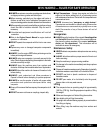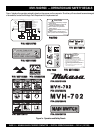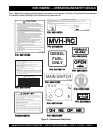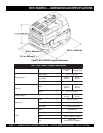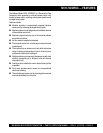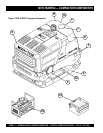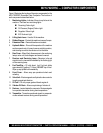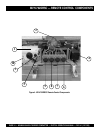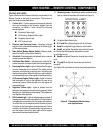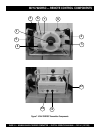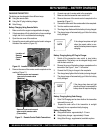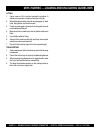
MQ-MIKASA MVH-702DRSC COMPACTOR — PARTS & OPERATION MANUAL — REV. #1 (12/17/03) — PAGE 17
MVH-702DRSC — REMOTE CONTROL COMPONENTS
CONTROL UNIT (BODY)
Figure 4 illustrates the location of the major components for the
Remote Control on the body of the machine. The function of
each component is described below:
1. Control Unit – Controls engine start/stop and hydraulic
valve unit according to the operation signals from the
transmitter. In addition, it also controls the following
monitoring lights:
Receiving Failure Light
Oil Pressure (Engine) Failure Light
Regulator Failure Light
E/G Overheat Light
2. Receiver and Receiving Lamp – Receives infra-red
signals from the transmitter indicated by the flashing light
on the receiving lamp.
3. Main Switch (Battery Master Switch) –Battery power
switch for control unit on body of machine.
4. Valve Unit – Electromagnetic and hydraulic valve; controls
traveling speed and direction.
5. Cell/Crank Start Switch – Selects electric (cell) start for
normal operation or manual (crank) start for emergencies.
6. Receiving Failure Light - Lights to indicate that the signal
from the transmitter is not received. The remote control
operation is restricted to a narrower area , the farther you
are from the machine. When this light is on, plate vibration
will automatically stop but the engine will continue running.
7. Oil Pressure (Engine) Failure Light –Lights to indicate
that the engine oil is low or the hydraulic oil pump is not
functioning properly. When this light is on, the engine will
automatically stop.
8. Regulator Failure Light – Lights to indicate that the
alternator and regulator are not functioning properly. When
this light is on, the machine is still operating. Check alternator
and regulator after operation.
9. E/G Overheat Light - Lights to indicate engine overheat. If
the engine is continuously overloaded or if the air element
is clogged due to excessive dust, the engine will overheat.
To correct this, run the machine without vibration for about
5 minutes or stop the engine to clean air element. If this is
not done, the machine will automatically stop vibration to
cool the engine, and will not start again until the engine
temperature reaches acceptable level.
10. Monitoring Lamp – Depending on which numbered lamps
light up, indicates the status of the machine (Figure 5).
1 is lighted: Main Switch is on.
9, 10, and 12 are lighted: Engine start by cell motor.
9 and 10 are lighted: Engine start by crank handle.
5 and 8 are lighted: Transmitter start switch is turned
on. Shortly after the transmitter start switch is turned
on, all lamps turn off.
6 and 8 are lighted: Transmitter vibration start switch
is on.
7, 8, and 12 are lighted: Transmitter start switch is
turned off.
See Figure 6 for correlation of monitor lamp and joystick lever.
1
2
3
4
5
6
7
8
9
11 12
10
MONITOR LAMP
Figure 5. Monitor Lamp
Figure 6. Correlation of Monitor Lamp
and Joystick Lever



